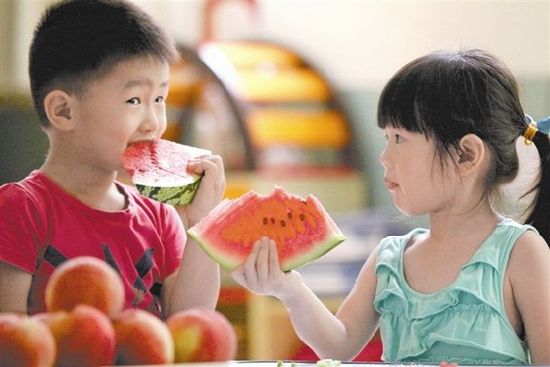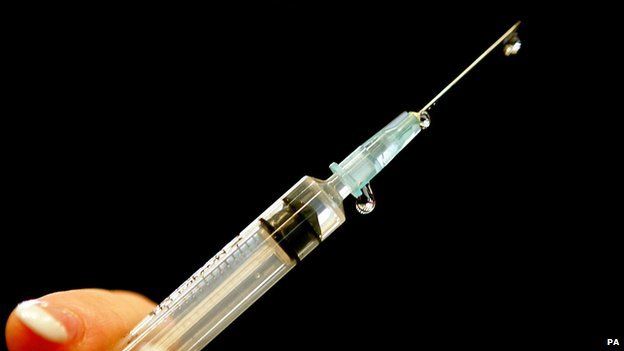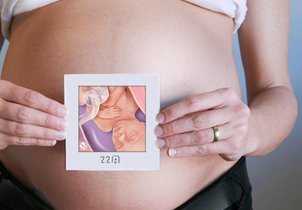马博士谈营养之二七七:立秋贴秋膘?

今天就要立秋了。立秋,是二十四节气中的第十三个节气,更是干支历未月的结束以及申月的起始,从时间上看,就是过了上半年,下半年开始啦。到了立秋,梧桐树开始落叶,所以有“一叶知秋”之说。“秋”由禾与火字构成,有禾谷成熟、丰收的意思。
“秋”意味着热去凉来,秋天的开始,天气由暑热模式逐步转换为凉寒模式。虽然“秋老虎”的余威不容忽视,但天气变凉爽是总趋势。根据时令节气调整饮食促进健康,是中华民族聪明智慧。而立秋作为夏秋之交的重要时刻,饮食自然是很讲究的。
立秋,北方有“贴秋膘”一说,相传清代人们在立秋这天,悬秤称人,和立夏日所秤之数相比,以验夏中之肥瘦。体重减轻叫“苦夏”,属于消耗多了。瘦了就需要“补”。“膘”多指牲畜的肥肉,补膘当然就需要吃肉啦。因此,立秋这一天,普通百姓家要吃炖肉,讲究一点的人家要吃白切肉、红焖肉,以及肉馅饺子、炖鸡、炖鸭、红烧鱼等。
以前,平常百姓家不能经常吃到鸡鸭鱼肉,人们的体重总体来说偏低,到立秋这天当然要借机改善下生活,贴贴膘啦!现在几乎天天大鱼大肉,有很多人已经属于超重肥胖啦。最近,卫生计生委发布的《中国居民营养与慢性病状况报告(2015年)》表明,全国18岁及以上成年男性和女性的平均体重分别为66.2和57.3千克;和10年前相比,居民体重还在增长。成人超重率为30.1%,肥胖率为11.9%,比2002年上升了7.3和4.8个百分点,6-17岁儿童青少年超重率为9.6%,肥胖率为6.4%,比2002年上升了5.1和4.3个百分点。
肥胖本是就是一种疾病,同时还是高血压、糖尿病等慢性疾病的危险因素。因此,对于体重属于超重肥胖的,不要盲目去贴“秋膘”,特别是吃肥肉贴秋膘!对于体重偏低的,特别是属于低体重的,膘还是可以适当地贴贴。
立秋除了“贴秋膘”,天津等地还流行“咬秋”。 人们相信立秋时吃瓜可免除冬天和来春的腹泻。清朝张焘的《津门杂记·岁时风俗》中就有这样的记载:“立秋之时食瓜,曰咬秋,可免腹泻。”清时人们在立秋前一天把瓜、蒸茄脯、香糯汤等放在院子里晾一晚,于立秋当日吃下,为的是清除暑气、避免痢疾。
立秋后天气干燥,饮食上还是强调:饮食有度、一日三餐,另外:
1、食物多样,谷类为主,吃些薯类,如山药。
2、肉类,建议经常吃些鱼、各种瘦肉、禽蛋。
3、少吃辛辣、煎炸的食品。
4、每天吃新鲜蔬菜、水果。
5、足量喝水,防秋燥。
6、趁着秋高气爽的好天气,多进行户外锻炼。
本文地址:http://www.wjbb.com/know/1189
原文出处:http://weibo.com/p/2304185d5947690102wqnd 收起阅读 »
反疫苗运动:为何有些家长抗拒为自己的孩子接种疫苗?

This spring saw the first death from measles in the United States in 12 years.
Measles infections there are at their highest since the disease was supposedly eradicated. The reason for this is that the number of people vaccinated against measles has been falling.
More and more parents have been refusing to immunise their children. The influence of a loose group of fringe campaigners against immunisation - "anti-vaxxers", as they're known - has been spreading. And with it, disease.
Vaccines can cause adverse reactions in a small number of people, like many medicines, but the accepted science is that the benefits far outweigh the risks. And that's why none of our expert witnesses this week is an anti-vaxxer.
Instead we're asking why, given the body of scientific evidence and the advice of national and global health authorities, has childhood immunisation become so controversial? What's behind the anti-vax movement? Four key players in the story share their thoughts.
Dyan Hes: Everyone must play their part
Dr Dyan Hes doesn't accept any patients at her children's clinic in New York who aren't up-to-date with their vaccinations.
"I make a promise to my patients that I will do my best to keep their children healthy. So if I have a patient that has cancer or leukaemia or any type of immunosuppressive illness and they sit in my waiting room and somebody comes in with measles and my patient dies, then I didn't keep my oath. That's how I feel.
"You need a population to be immunised to protect the people who cannot be immunised."Measles virusIf the vast majority of people in a community have had their vaccination against a disease, and then someone turns up from out of town carrying the disease, it's unlikely they'll come into contact with anyone it can pass on to. The disease won't spread. And especially vulnerable people, who can't be immunised, will be safe.
This is called "herd immunity".
"Right now in Seattle, Washington, in the United States, 80 to 88% of children are immunised for polio. But you need a 95% rate of polio immunisation to keep up herd immunity. So polio can theoretically re-emerge in Seattle, Washington because there are so many people who are not being immunised at this time."
The first successful vaccine was the smallpox vaccine, developed in the late 1700s. But ironically it's the success of childhood immunisation programmes which has in part started the backlash against them. Dr Hes says parents don't see the point in taking action against a disease they've never known anyone to suffer from.
"They don't see that so they don't know, so they say, 'What's the big deal? It's a rash, you know, it won't be my kid.' But people forget what childhood death is and what infantile mortality is, people forget how many children died or were left with encephalitis or terrible brain diseases that caused mental retardation and people to be institutionalised for the rest of their life from measles."
Brian Deer: Bad science
Brian Deer is an investigative journalist for the British newspaper The Sunday Times.
"There was a paper published in February 1998 in The Lancet and basically what it said was that there was a group of parents who brought 12 children to a hospital in North London here in England. Those parents said that they gave their child the MMR [measles, mumps and rubella] vaccine and within 14 days, eight of the families said their child had developed the first signs of autism.
"And the paper also said these same children had a new kind of inflammatory bowel disease which, taken together, was a new syndrome in children and it set off the most extraordinary public alarm.Investigative journalist Brian Deer: I am subject to relentless abuse"When this story broke, very quickly parents started to shun the MMR vaccination. This man, Wakefield, went on television and it was reported at saturation levels, his recommendation that the MMR should be suspended in favour of vaccinating your children with single shots. But many parents just didn't vaccinate their child and we started to see outbreaks of measles. In fact, I had the misfortune to report the first measles death in the UK resulting from this scare. It was an absolute panic and a real public health crisis."
But something didn't quite ring true about the story to Brian. He began to take a closer look at the scientist behind the research, Andrew Wakefield.
"I went to interview one of the mothers of the children in the research and she told me a story that was completely different to the story that she'd told to participate in the research that led to the 1998 Wakefield paper. It was a different story."
Brian Deer found inconsistencies in a number of the paper's case studies and questioned how impartial the research was. The medical authorities began to investigate Andrew Wakefield's research methods. It took years. He was eventually found guilty of serious professional misconduct, and struck off the medical register. The Lancet withdrew the paper. But all this happened 12 years after the study was first published.
No scientist has been able to replicate the study's findings. No study has since found any link between the MMR vaccine and autism. And yet the story hasn't gone away.
"In the UK the British public is now pretty apprised of the situation. Vaccination uptake levels of MMR have gone back to where they were before Andrew Wakefield's paper, but this story is now rolling out across the world.
"I am subject to relentless abuse, emails telling me that how can I sleep at night because of what I've done and that I'm working for the drug industry and that I'm somehow involved in some sort of global conspiracy to harm children."
Juniper Russo: Changed view
Juniper Russo is a single mother living in the city of Chattanooga in the southern US state of Tennessee, and used to be part of the anti-vax movement.
"Andrew Wakefield's study was one of the things that had really scared me. People who are in the anti-vaccine movement largely believe that he was silenced and that he was actually a hero who was speaking up about something important."
Juniper now writes a blog, Back From Nature, in which she advocates evidence-based healthcare. Like journalist Brian Deer, she's faced a vicious backlash and even threats from anti-vaxxers for changing her views. But at one time there was no question in her mind: vaccinations were a conspiracy.
"I was only 20 when I got pregnant with my daughter and I was really young and really naive and I had gotten wrapped up in this world view that said that nature is just this wonderful thing and that everything about our big scary industrialised world was bad.Blogger Juniper Russo changed her view on vaccination"I thought that the government wasn't to be trusted and I very much believed in the idea that there was this big organisation called Big Pharma and I thought that people would be willing to make my child sick to make a dollar.
"All that I could think about was that I was doing what I needed to do to protect my children from this beast of modern medicine. I didn't think about the possibility that I was putting anyone else in danger, but I now know that I was."
But Juniper's views changed after her daughter, who had never had a vaccination, was diagnosed with autism.
"That was the beginning of me starting to face that I had made a mistake in assuming that if I did everything in this perfect... way that nothing wrong would ever happen to my kids.
"I was seeing a lot of it on the news, and I now realise that it was actually very irresponsible of the media. They would have a physician who worked with the World Health Organization on TV, and then debating with him they would have a mum who said that her kid had autism from the vaccine.
"It was very easy for me to side with the person that I could relate to the most, instead of siding with the big scary doctor who was, I assumed, paid off by the government."
Heidi Larson: Managing the conversation
Heidi Larson, an anthropologist at the London School of Hygiene and Tropical Medicine, has dedicated her career to understanding how people feel about vaccines.
"The reason that [people] get more entrenched [in their opposition to vaccination] is they feel like they're not being listened to. So you don't throw information at the problem. Instead you learn to listen.Heidi Larson: We're not focusing enough on scientists understanding the public"I do think we need to do a much better job at supporting health workers and health professionals to have difficult conversations. They're absolutely not trained to manage a conversation which is challenging what they do.
"It's very much... you get trained as a doctor, a health worker, a nurse, to deliver these good things that are going to help the health of the public, [to] give people the jab.
"Increasingly people have the performance indicators and they feel like they have to check so many off and I've had interviews with people that say, 'I feel like a number. You know, I'm in, I'm out, get the jab.'
"Additionally there's all this focus on the public understanding the science. I think we're not focusing enough on scientists understanding the public.
"We can't keep finger pointing at the public and think they're the issue."
中文翻译:
本文地址:http://www.wjbb.com/know/1188
原文出处:http://www.bbc.co.uk/news/health-33774181 收起阅读 »
真或假:生的蔬菜比煮熟的更健康?

Cooking is crucial to our diets. It helps us digest food without expending huge amounts of energy. It softens food, such as cellulose fiber and raw meat, that our small teeth, weak jaws and digestive systems aren't equipped to handle. And while we might hear from raw foodists that cooking kills vitamins and minerals in food (while also denaturing enzymes that aid digestion), it turns out raw vegetables are not always healthier.
A study published in The British Journal of Nutrition last year found that a group of 198 subjects who followed a strict raw food diet had normal levels of vitamin A and relatively high levels of beta-carotene (an antioxidant found in dark green and yellow fruits and vegetables), but low levels of the antioxidant lycopene.
Lycopene is a red pigment found predominantly in tomatoes and other rosy fruits such as watermelon, pink guava, red bell pepper and papaya. Several studies conducted in recent years (at Harvard Medical School, among others) have linked high intake of lycopene with a lower risk of cancer and heart attacks. Rui Hai Liu, an associate professor of food science at Cornell University who has researched lycopene, says that it may be an even more potent antioxidant than vitamin C.
One 2002 study he did (published in the Journal of Agriculture and Food Chemistry) found that cooking actually boosts the amount of lycopene in tomatoes. He tells ScientificAmerican.com that the level of one type of lycopene, cis-lycopene, in tomatoes rose 35 percent after he cooked them for 30 minutes at 190.4 degrees Fahrenheit (88 degrees Celsius). The reason, he says: the heat breaks down the plants' thick cell walls and aids the body's uptake of some nutrients that are bound to those cell walls.
Cooked carrots, spinach, mushrooms, asparagus, cabbage, peppers and many other vegetables also supply more antioxidants, such as carotenoids and ferulic acid, to the body than they do when raw, Liu says. At least, that is, if they're boiled or steamed. A January 2008 report in the Journal of Agriculture and Food Chemistry said that boiling and steaming better preserves antioxidants, particularly carotenoid, in carrots, zucchini and broccoli, than frying, though boiling was deemed the best. The researchers studied the impact of the various cooking techniques on compounds such as carotenoids, ascorbic acid and polyphenols.
Deep fried foods are notorious sources of free radicals, caused by oil being continuously oxidized when it is heated at high temperatures. These radicals, which are highly reactive because they have at least one unpaired electron, can injure cells in the body. The antioxidants in the oil and the vegetables get used up during frying in stabilizing the cycle of oxidation.
Another study published in the Journal of Agricultural and Food Chemistry in 2002 showed that cooking carrots increases their level of beta-carotene. Beta-carotene belongs to a group of antioxidant substances called carotenoids, which give fruits and vegetables their red, yellow, and orange colorings. The body converts beta-carotene into vitamin A, which plays an important role in vision, reproduction, bone growth and regulating the immune system.
The downside of cooking veggies, Liu says: it can destroy the vitamin C in them. He found that vitamin C levels declined by 10 percent in tomatoes cooked for two minutes—and 29 percent in tomatoes that were cooked for half an hour at 190.4 degrees F (88 degrees C). The reason is that Vitamin C, which is highly unstable, is easily degraded through oxidation, exposure to heat (it can increase the rate at which vitamin C reacts with oxygen in the air) and through cooking in water (it dissolves in water).
Liu notes, however, that the trade-off may be worth it since vitamin C is prevalent in far more fruits and vegetables than is lycopene. Among them: broccoli, oranges, cauliflower, kale and carrots. Besides, cooked vegetables retain some of their vitamin C content.
That said, research shows that some veggies, including broccoli, are healthier raw rather than cooked. According to a study in the Journal of Agricultural and Food Chemistry in November 2007, heat damages the enzyme myrosinase, which breaks down glucosinates (compounds derived from glucose and an amino acid) in broccoli into a compound known as sulforaphane.
Research published in the journal Carcinogenesis in December 2008 found that sulforaphane might block the proliferation of and kill precancerous cells. A 2002 study in The Proceedings of the National Academy of Sciences also found that sulforaphane may help fight the bacterium Helicobacter pylori, which causes ulcers and increases a person's risk of stomach cancer.
On the other hand, indole, an organic compound, is formed when certain plants, particularly cruciferous vegetables such as broccoli, cauliflower and cabbage, are cooked. According to research in The Journal of Nutrition in 2001, indole helps kill precancerous cells before they turn malignant. And while boiling carrots was found to increase carotenoid levels, another study found that it leads to a total loss of polyphenols, a group of chemicals found in raw carrots. Specific polyphenols have been shown to have antioxidant properties and to reduce the risk of cardiovascular disease and cancer, according to a 2005 report in The American Journal of Clinical Nutrition.
Comparing the healthfulness of raw and cooked food is complicated, and there are still many mysteries surrounding how the different molecules in plants interact with the human body. The bottom line, says Liu, is to eat your veggies and fruits no matter how they're prepared.
"We cook them so they taste better," Liu says. "If they taste better, we're more likely to eat them." And that's the whole idea.
中文翻译:
本文地址:http://www.wjbb.com/know/1187
原文出处:http://www.scientificamerican.com/article/raw-veggies-are-healthier/ 收起阅读 »
压力所致:25岁之前就做了父亲的男人更可能中年早逝

Young dads more likely to die middle aged - is stress of fatherhood killing them?
A Finnish study tracked more than 30,000 men - those who became dads in their early 20s were more likely to die early
Under pressure: Fatherhood can be stressful
Men who become dads before they turn 25 run a higher risk of dying in middle age, research has found.
The stress of fatherhood at a young age can cause serious health problems, the study suggests.
Lead researcher Dr Elina Einio said: “The findings provide evidence of a need to support young fathers struggling with the demands of family life in order to promote good health behaviours and future health.
“Promotion of good health behaviours in young fathers could also support healthy behaviour in their children.”
Dr Einio’s team from the University of Helsinki, Finland, tracked more than 30,000 men over 20 years from 1985 to 2005.
Danger: Young fathers are more at risk of premature deathThose who had become dads before the age of 22 were 26% more likely to die early than those who left it until they were 25.
Similarly, men who had their first children aged between 22 and 24 were at a 14% higher risk of premature death.
At the other end of the scale, those who became dads between the ages of 30 and 44 had a 25% lower risk of death in middle age than young dads. The results were irrespective of their year of birth, upbringing, education, marital status, where they lived and the total number of children they had.
Experts believe the premature deaths could be down to the combined stress of being a father, partner and breadwinner at a young age.
But statistics expert Professor Kevin McConway, of the Open University, warned: “The researchers suggest increased mortality might be due to the extra responsibilities of parenthood and accumulation of the stresses of life.
“That’s plausible. But these fathers grew up in Finland during and soon after the Second World War. Social conditions in, say, Britain now are very much different from their experience.
“We just don’t know whether the findings would be the same for young men nowadays, in Finland or anywhere else.”
The research is published in the Journal of Epidemiology & Community Health.
中文翻译:
本文地址:http://www.wjbb.com/know/1186
原文出处:http://www.mirror.co.uk/lifestyle/health/young-dads-more-likely-die-6188915 收起阅读 »
怀孕生孩子那些事之唐氏筛查的纠结

怀孕是一件喜事,但是这种喜悦不会持续很久,在接受了一圈的祝福之后,接下来要面对的是很多的纠结。纠结在哪家医院建卡定期产检,纠结看哪位医生,纠结是自己生还是剖宫产,纠结是生男孩好还是女孩好,纠结会不会被会阴侧切。但是这些纠结与唐氏筛查和羊膜腔穿刺的纠结相比,简直是小巫见大巫。
不做唐氏筛查纠结:万一孩子生出来是个唐氏综合征宝宝(唐宝宝)怎么办?
做了唐氏筛查也纠结:高风险需要做羊水穿刺很纠结,低风险并不是没有风险也纠结。
羊水穿刺纠结:不做怕真的生出个“唐宝宝”,做了又怕手术导致的流产。
这种令人两难的Dilemma让我想到了普陀山的一句够狠的广告语:“想到了就去普陀山”。这句话的意思是:想到了就得去,如果不去的话,后果XXX。所以只要想到了,就会纠结,除非你不去想。其实,做唐氏筛查就是一种赌博,赌的是唐氏综合征的概率,35岁以下正常孕妇中胎儿是唐氏综合征的发生概率为1/800左右,做了唐氏筛查就会得到一个数字,这个数字理论上就是这个胎儿为“唐宝宝”的概率,当然这个概率越低越好。不过同样一个风险概率在不同人的眼里是完全不一样的理解,在有些人眼里,1/1000的风险也很高,而在有些人眼里,1/100的风险也很低。
在看门诊时,两种极端的病人都会遇到。有些人一点也不纠结,有些人就非常纠结,我曾经有过一个唐氏筛查风险1/250的患者,早上八点多就开始和我谈,期间为了和丈夫和婆婆妈妈商量究竟要不要做羊穿三进三出,直到中午十二点多所有病人都看完了,她还没有打定主意。我估计这种人不仅仅是遇到唐氏筛查会纠结,遇到其他的事情肯定也很纠结,哪位星座高手可以指点一下哪些星座平时是很纠结的,这样我看门诊时就可以有思想准备了。
看到这里也许会有人不耐烦地说,你说了半天都是没有意义的话,能否给点实在的,可以帮助我们做决定的建议。好吧,下面就是我的建议,既然唐氏筛查本质上就是赌博,就是赌概率,那就要按照赌博的规矩来。
赌博的最主要原则是“愿赌服输”:
要输得起才可以去赌,比如面对1/250的唐氏风险,不要有侥幸心理,说我不做羊穿,因为我不会这么倒霉吧,一旦赌输了,孩子真的生出来是个“唐宝宝”,你就得坦然地去面对。赌的时候不是看赢面有多大,而是要看自己能否输得起,输不起千万不要去赌,哪怕是比较低的概率。如果是输得起,即使是1/50的概率也可以很坦然地去面对。
两害相权取其轻
如果选择不做羊穿,赌输了的结果是生出来一个“唐宝宝”;如果选择做羊穿,赌输了,最坏结局是流产,然后下次重新再来。羊穿流产的理论概率大概在1/300左右,实际流产概率在每个产前诊断(胎儿医学)中心是不一样的,在我们一妇婴胎儿医学中心,羊穿后流产的概率大约在0.5/1000,基本上和不做羊穿的病人在相应孕周的自然流产率相差无几。了解了赌输的后果和概率,究竟是做还是不做,相权之后做个决定没那么困难吧?
越简单越快乐
其实怀孕是个试错的过程,整个孕期会有很多的对母亲和胎儿不利的概率出现,只要进行正规的产检,多数风险是可控的。这些问题还是让医生帮你操心吧,你瞎操心也没有用。千万不要自己在网上请教“百度医生”,无端地增加自己的烦恼,越简单越快乐,好好享受整个孕期吧!
本文作者:段涛医生
本文地址:http://www.wjbb.com/know/1185
原文出处:http://mp.weixin.qq.com/s?__biz=MzA4MjUxNTkwNg==&mid=200711696&idx=1&sn=c1d7bb88d20771dec31b4bbd947d301e&3rd=MzA3MDU4NTYzMw==&scene=6#rd 收起阅读 »
怀孕生孩子那些事之胎儿磁共振

胎儿结构畸形的筛查超声为首选
超声检查具有无创﹑快速﹑实时﹑廉价﹑准确的特点,与其他复杂的影像学检查比较有其不可替代的优势。但是超声检查也有不足:难以穿越胎儿颅骨,视野偏小,对于存在母亲肥胖﹑母体子宫肌瘤﹑羊水过少﹑多胎等情况时,检查结果常不满意,而且超声检查受胎儿体位影响,常需较长时间或进行多次检查。另外,超声诊断或多或少受到操作者技术水平的限制。
胎儿磁共振(MRI)是产科超声检查非常重要的补充手段
1983年,Smith等首次报道胎儿MRI检查,近年来胎儿磁共振发展迅速,全国多家医院陆续开展。随着胎儿宫内手术及产房新生儿外科手术的发展,对胎儿影像学检查提出更高的要求。胎儿MRI可以对超声检查存有疑问的宝宝做进一步针对性的诊断,能够在胎儿期对疾病做出及时正确的诊断和分类,帮助制定合适的后续手术方案,另外胎儿MRI还能帮助母亲选择分娩方式。
孕期进行MRI检查安全吗?
由于存在电离辐射,一般不建议在孕期进行X线检查和CT检查,但是会建议进行MRI检查。因为无论是从成像原理,还是从循证医学的证据来讲,MRI对于胎儿来讲都是安全的,不会对胎儿发育产生不良影响。
胎儿MRI的优势
不存在电离辐射;软组织分辨率高;视野大,可以任意切面扫描,显示胎儿全貌;受母亲情况影响小;不受胎儿骨骼及羊水量影响;对胎儿中枢神经系统疾病、羊水过少相关疾病和胸部疾病诊断方面有很高的准确性,在其他部位图像有良好的直观性和分辩率,并能量化评价肺发育不良。对于双胎及孕周较大时影像显示明显优于超声检查,特别是孕晚期胎头入盆或胎儿颅骨骨化时;胎儿MRI可进行任意切面扫描,精确地进行各种测量,对于胎儿疾病的定性较好,还可进行功能成像如磁共振波谱成像(MRS);MR图像受检查操作者技术水平影响较小,便于保存和会诊。
胎儿MRI的推荐检查指征
1. 首选指征和诊断价值最大的是胎儿中枢神经系统异常:如脑发育不良、侧脑室或后颅窝明显增宽、Dandy-Walker畸形、胼胝体发育不良、Chiari畸形、脑出血、脑肿瘤、脑积水、无脑儿、前脑无裂畸形、神经管闭合不全、脑脊膜膨出等。值得一提的是,当胎儿胼胝体发育不良或胼胝体缺如时,超声往往提示双侧侧脑室增宽,而无法辨别胼胝体是否存在,此时胎儿MRI可以协助确诊侧脑室增宽是否由胼胝体发育不良引起,或者是单纯侧脑室稍增宽而无脑实质发育异常,这对于妊娠结局至关重要。
2. 胎儿颌面部畸形:如唇裂、腭裂、眼眶发育不良或眼球缺失等,可以通过胎儿MRI进行进一步的确认和补充,同时可以发现是否合并其他相关畸形。
3. 胎儿胸部肿瘤性病变:超声提示胎儿肺部回声增强,最常见的是胎儿肺囊腺瘤样畸形(CCAM)或隔离肺,二者都属于良性病变但常常不易区分。胎儿MRI可以通过各个断面扫描,判断异常病灶内的血供来源,从而可以明确病变性质,因为某些CCAM具有自限性,即出生后自行消失,无需治疗。而隔离肺分为肺内型和肺外型,出生后可以进行手术治疗。
4. 胎儿腹部肿瘤性病变:这种情况往往很难定性,胎儿MRI可以明确病灶来源,从而进一步明确病变性质。比如肝脏血管内皮瘤,肾脏中胚叶肾瘤等等,囊性病变包括胆总管囊肿、消化道重复畸形,(女性)卵巢良性囊肿等。
5.胎儿泌尿生殖系统异常:超声发现胎儿肾盂分离,MRI可以进一步明确胎儿肾积水原因,如肾盂输尿管连接处梗阻(UPJO)、膀胱流出道梗阻、输尿管异位开口等。胎儿肾脏发育不良如马蹄肾、异位肾、多囊性发育不良肾(MCDK)、婴儿型多囊肾等,可以通过MRI进一步判断肾脏功能。如果超声在肾脏区域未见到肾脏回声,胎儿MRI可以通过不同断面扫描及弥散功能成像来判断是胎儿肾脏发育不良还是(盆腔)异位肾等。
6. 胎儿胃肠道异常:可以通过MRI检查来进一步明确诊断,确认进一步处理方案。这些异常主要包括先天性食道闭锁、十二指肠闭锁、小肠与结肠梗阻或闭锁、肛门闭锁、胎粪性腹膜炎等。
7.胎儿四肢的异常:胎儿MRI可以帮助进一步甄别这些异常,比如确认是马蹄内翻足还是仅仅暂时性内翻状态,肢体缺如或发育不良,多指/趾或少指/趾畸形,胎儿MRI可以明确肢体附近囊性灶是羊膜束带引起的水肿还是软组织淋巴管瘤。如果发现胎儿双下肢显示不清或融合,胎儿MRI可以协助判断是宝宝调皮地变换姿势还是人体鱼序列征。
8. 胎儿脊柱异常:如脊柱裂、脊髓脊膜膨出、半椎体、脊髓栓系、骶尾部畸胎瘤等,胎儿MRI可以一目了然,有理有据。
9. 胎儿心脏异常:MRI诊断胎儿心脏异常比较复杂,最好到心脏专科比较好的儿科专科医院检查。
10. 双(多)胎:IVF治疗往往收获双胎或三胎,问题也随之而来。比如双胎输血综合征(TTTS)、双胎反向动脉灌注序列综合征、双胎/多胎之一死亡,胎儿MRI可以帮助监测宫内胎儿生长发育情况,观察存活胎儿中枢神经系统是否异常,减胎减掉哪一个等。
11. 其他需要进行胎儿MRI检查的情况:如孕妇过度肥胖、羊水过多/少、存在复杂畸形时,孕晚期胎头入盆、胎儿颅骨骨化、前置胎盘,胎盘早剥(出血)、胎盘植入、瘢痕妊娠、孕妇子宫畸形、胎儿宫内生长受限、胎儿腹裂及脐膨出等。
目前,胎儿MRI得到了越来越多的应用,已成为产科超声检查的重要补充手段,并能提供超声不能发现的额外信息。胎儿MRI检查时噪声较大,子宫内的宝宝往往会在检查有比较明显的胎动。胎儿MR检查时,孕妇一般不使用镇静剂及对比剂,应当尽量避免怀孕3个月(孕早期)内扫描,孕4个月后胎儿MRI图像容易理解。
结论:超声是胎儿畸形的首选筛查手段,对于部分器官和系统的异常(特别是中枢神经系统),胎儿MRI可以帮助进行进一步的确诊。
本文作者:段涛医生
本文地址:http://www.wjbb.com/know/1184
原文出处:http://mp.weixin.qq.com/s?__biz=MzA4MjUxNTkwNg==&mid=200617558&idx=1&sn=01aaeb15dd8a19e16219222918a5b9c7&3rd=MzA3MDU4NTYzMw==&scene=6#rd 收起阅读 »
怀孕生孩子那些事之科学坐月子

关于需不需要坐月子,如何坐月子,有很多不同的说法,归纳起来大致有三种:婆婆妈妈的老看法是一定要坐月子,而且有很多的讲究和禁忌;另外一种是很多年轻妈妈的看法,根本不需要坐月子,产后该干嘛就去干嘛;第三种看法是介于前两者之间。虽然依然有很多争议,但是并不妨碍“月子会所”的红火发展,遍地开花。随着海峡两岸的经济交流,很多原来只有在台湾才有的商业业态在大陆也迅速传播开来,月子会所就是其中之一。月子会所的发展势头有点类似婚庆公司,以前结婚很少人会去用婚庆公司,在大一些的城市,现在结婚谁不用婚庆公司好像反而显得有些另类了。
坐月子是中国特色
坐月子也算是中国的国粹,外国人从来没有坐月子的说法,她们不坐月子身体照样比我们中国人好,也没什么人得所谓的“月子病”。更有甚者,她们非但不坐月子,还要打破我们很多的月子禁忌。前段时间我的一个美国准妈妈在和我商量分娩计划时提出了一些要求,相信会让很多的婆婆妈妈瞠目结舌的。这位美国准妈妈的要求包括:生完了要给我喝冰水,我要马上洗澡……。一些年轻的准妈妈们之所以不想坐月子,就是因为持同样的看法。
以前坐月子是有一定道理的
对于坐月子,我们应该持正确的科学观和历史观去看待,“存在的即是合理的”。以前中国人坐月子是有一定道理的,大家应该知道在以前做媳妇是很辛苦的。一大家子十几口到几十口人,全家的衣服要媳妇去缝补和洗晒,全家人的饭菜要媳妇去做,孩子要媳妇去带,还有N多的其他的家务也要媳妇去做。那时候既没有洗衣机,也没有空调,更没有热水澡和电吹风。那时候没有避孕措施,孩子一个接一个的生,营养条件也不好,普遍存在贫血、缺钙等营养不良性疾病。所以以前在坐月子期间营养要大补,要一天吃一个老母鸡,要补血气,要不能洗澡和洗头(没热水啊,没空调啊),要怕受风寒(包着头巾,穿厚衣服),要多休息少活动,不能吃生冷食物(没冰箱食物容易变质)。平时媳妇十分操劳,好不容易到了生孩子的时候可以有一个月的时间可以休息一下,可以有机会补充一下营养,真的是应该的。
现在情况完全不同了,谁家的媳妇还会像以前那么操劳呢?谁家的媳妇还会营养那么差呢(现在是营养过剩的太多)?谁家还没有洗衣机,空调,热水澡和电吹风呢(当然不能绝对,可能少数家庭还是没有的)?所以现在还要坚持说坐月子不能刷牙(怕缺钙,刷牙会导致牙齿脱落),不能洗头、洗澡、吹风(怕受寒),要大补(怕营养不够),不能出门(怕劳累留下月子病),是绝对没有道理的。
现在应该如何科学坐月子?
科学坐月子的原则是不要走极端,营养要均衡,生活方式要合理。在饮食方面,要健康、均衡、有营养、不过量,原则上什么都可以吃。可以吃大闸蟹吗?可以(别大闸蟹当饭吃)!可以吃生鱼片吗?可以(你老公可以放心吃的你就可以吃)!可以喝咖啡吗?可以(别太多)!可以吃冰激凌吗?可以(解解馋就可以了)!以前中国人讲究“补”,补的方式主要是补血气,这和以前多数中国人营养缺乏有关,现在大多数人是不需要补的,更加要注重的是营养均衡。
在生活方式方面,要注意休养,但千万不要天天躺在床上,很多事都可以做,但不要太过分。可以刷牙,可以洗澡洗头,可以开空调(注意不要太冷,不要直吹),可以看电视(别像沙发土豆一样看太久),可以玩手机看我微信公众号和微博上的科普文章,出了月子恶露干净后就可以恢复性生活了(最好用安全套,哺乳期依然可能有排卵,是有可能怀孕的)。出了月子可以逐步恢复运动,2-3个月后可以逐步回到孕前的运动量了。
中国人的哲学是以“中庸”为主的,在一个中庸的社会里,出现这么极端的“坐月子”的做法是有些奇怪的,大家慢慢改吧。
本文作者:段涛医生
本文地址:http://www.wjbb.com/know/1183
原文出处:http://mp.weixin.qq.com/s?__biz=MzA4MjUxNTkwNg==&mid=200654406&idx=1&sn=9d0ea3600fba3f74a2e931d345e9869c&3rd=MzA3MDU4NTYzMw==&scene=6#rd 收起阅读 »
怀孕生孩子那些事之早产的预防

背景
早产是全球围产儿患病与死亡的首要病因,据文献报道,75%的围产儿死亡归结于早产。美国37周之前的早产率约为12%,中国约为4.5%,不过请注意,包括美国在内的发达国家的早产孕周定义为24-37周,而中国则采用WHO的定义,早产孕周为28-37周。所以在比较中国和美国早产儿存活率时千万不要有中国早产儿救治水平和美国相比较并不差结论,因为多数的早产儿死亡和严重致残发生在孕24-28周的早产儿。既然治疗效果差,预测和预防就显得更加重要。
机制
子宫像一个口袋,宫颈像是扎起来的袋口,足月以后产程启动,口袋逐渐紧缩,袋口逐渐打开,口袋里的孩子就出来了。早产的主要原因是袋口过于松弛,口袋稍有紧缩,孩子就会漏出来。要想预防早产,得先预测那些孕妇会容易发生早产,目前比较靠谱的预测指标有两个,一个是早产病史,另外一个是经阴道超声下对宫颈管长度的测量。目前常用的预防早产的方法有三种:孕激素的作用机制是让口袋(子宫)更加安静,不要乱收缩,宫颈环扎是扎紧袋口(宫颈),宫颈托的作用是压迫及支持宫颈,而且通过改变颈管轴向转移子宫对宫颈内口的作用力,预防宫颈内口的进一步开大,这样孩子就不会太早出来。
孕激素
已经有循证证据证实,对有早产史或超声下测量宫颈短的单胎孕妇使用孕激素可以降低约1/3的早产风险,但对双胎或足月前胎膜早破者目前尚不支持使用。能够预防早产的孕激素主要为17α羟己酸孕酮酯、微粒化孕酮凝胶和阴道孕酮凝胶。相比阴道放置的孕酮凝胶,证据更加支持17α羟己酸孕酮酯的每周肌内注射,只是国内尚没有这种肌肉注射的药物。虽然有一定的效果,但并不能将补充孕激素作为预防早产的一种万能药,据文献报道,即使选择最适宜人群,孕期补充孕激素也仅能将美国的早产率降低不到2%(从12.1%降低至11.8%)。其实预防早产的目标太高,能够延长孕周,提高早产儿的存活率已经很不错了。
宫颈环扎
有临床研究证实,通过宫颈环扎术可以降低两种人群的早产率,一是对宫颈机能不全者进行预防性宫颈环扎,二是对有早产或晚期流产史,妊娠24周前宫颈长度<25mm的单胎妊娠行环扎术。宫颈机能不全的诊断需要结合病史和经阴道超声下宫颈长度的测量综合判断。对于比较明确的宫颈机能不全,需要行20例宫颈环扎术方能预防1例33周之前的早产。对于宫颈锥切术后患者,目前的研究认为预防性或紧急宫颈环扎不能降低这类人群自发性早产的发生率。对双胎妊娠,目前的证据认为宫颈环扎非但不能预防早产,反而增加了双胎妊娠的早产率。
宫颈托
宫颈托(Arabin Pessary)是近几年比较热门的一种方法,由于其无创伤性,操作简便,副作用小不增加感染,病人耐受性好而非常受欢迎。宫颈托预防早产的主要证据来源于2012年发表于LANCET(柳叶刀)杂志上的随机对照研究(PECEP研究),研究结论为孕中期宫颈长度≤25mm的单胎妊娠使用宫颈托可以降低早产发生率(12% vs27%)。对于宫颈托在双胎妊娠中早产预防的价值,多数研究持肯定态度,对宫颈短者可以延长孕周4周左右。2013年,荷兰对823例16-20周宫颈短的双胎孕妇进行了随机对照研究,结果发现宫颈托治疗组32周之前的早产率(14%vs29%; RR, 0.49)、不良新生儿预后发生率(12% vs 29%,RR:0.40)及出院前新生儿死亡率(2% vs 15%; RR, 0.13)均显著低于对照组。对于宫颈锥切术后的孕妇,观察性研究显示宫颈托联合阴道孕酮放置对这类人群可能有效。由于目前的研究证据有限,宫颈托究竟对哪类人群有效,有没有其他副作用,尚需要大样本的随机对照研究进一步证实。
其他
目前证据支持抗生素治疗无症状性菌尿可以预防早产;戒烟和停止使用可卡因可能有益于降低早产;而治疗无症状性滴虫、支原体感染、细菌性阴道病,治疗牙周病,卧床休息,在家自测宫缩并预防性使用宫缩抑制剂,增加产检次数在预防早产方面均没有得到足够的证据支持。
误区
1.过度诊断与过度治疗:由于宫颈机能不全缺乏诊断金标准,故临床上的诊断五花八门,有手诊法、Hegar探宫法、超声法、病史法及宫腔镜法等,往往会导致过度诊断和过多干预。有文献报道,至少1/2根据病史进行的宫颈环扎是没有必要的,而且,也要考虑宫颈环扎的可能并发症诸如感染、胎膜早破、宫颈撕裂等。
2.滥用没有循证医学证据支持的药物或方法:虽然没有循证医学证据的支持,依然会有很多的医生让病人用一般的黄体酮,“挂盐水”,和严格卧床休息来“保胎”,也在国内催生了很多的所谓“保胎病房”和“保胎医院”。
Q&A
1.既然经阴道超声测量宫颈管长度是有效的早产风险筛查手段,为什么不在人群中开展普遍筛查?
经阴道超声测量宫颈管长度最初是在高危人群中开展起来的,后来被发现在低危人群中也可以有效筛查出早产高风险的病人。但是后来在其他国家和地区的不同低危人群中验证时发现宫颈管缩短的发生率比较低,因此全面开展筛查的必要性收到质疑。
另外,经阴道测量宫颈管的长度有严格的标准,医生需要进行正规的培训,否则质量难以保障,这一技术障碍也阻碍了在人群中的全面推广。
2.黄体酮,宫颈环扎,宫颈托哪个治疗效果更好?
从meta分析来看,这三种方法预防早产的效果没有明显的差异,但是缺乏大样本,多中心,前瞻性的比较三种方法临床疗效的研究来进一步证实。
如何选择预防早产的医生和医院?
1.医生要有很好的综合预测早产的方法和经验,超声医生受过专门的经阴道测量宫颈长度的培训。
2.医生掌握各种预防早产的技术,有丰富的临床经验,可以根据患者的实际情况,采用综合手段预防早产(孕激素,宫颈环扎,宫颈托),而不是只拘泥于一种方法。
3.这家医院一定要有很好的新生儿科,要问医生要这家医院不同孕周早产儿的存活率。
总之,自发性早产的预防需要选择正确的人群进行个体化治疗,目前的证据更加支持34周之后不再积极保胎,因为34周之后新生儿的不良预后发生率大大降低。但是由于这些证据主要来自于发达国家,所以在中国执行时还要考虑到当地的新生儿科的水平,给宝宝选择合适的出生时间。
本文作者:段涛医生
本文地址:http://www.wjbb.com/know/1182
原文出处:http://mp.weixin.qq.com/s?__biz=MzA4MjUxNTkwNg==&mid=200766702&idx=1&sn=4c72cf1aae86aa72e221ba7a5b14bcf9&3rd=MzA3MDU4NTYzMw==&scene=6#rd 收起阅读 »
怀孕生孩子那些事之左侧卧位

在进入妊娠中晚期以后,医生往往会建议准妈妈们在睡觉的时候要左侧卧位,至于为什么要左侧卧位,没有几个人能说的很明白。其实建议左侧卧位的依据是人体大血管的位置,我们的脊柱位于人体的正中间,下腔静脉位于脊柱的右侧,腹主动脉位于脊柱的偏左侧(少数怪人例外)。进入妊娠中晚期,如果睡觉时依然采取仰卧位的话,沉重的子宫会同时压迫下腔静脉和腹主动脉,不少准妈妈会血液循环受影响,人比较难过,出现心慌气短等不适症状,无法入睡。由于同样受压的情况下,静脉受影响的程度比动脉要大,所以一般会建议左侧卧位,宁愿压迫腹主动脉。
如何左侧卧位?
应该是15-30度左侧卧位,而不是90度左侧卧位,试一下你就知道了。90度左侧卧位有时会比较难受,而且这种姿势比较难以长时间保持。入睡时是左侧卧位,但睡着以后老是会不自觉的翻身转换姿势怎么办?最好是用长条枕头放在身体的一侧,这样就不会乱翻身了。
左侧卧位难受怎么办?
建议左侧卧位的主要原因是怕你难受,如果左侧卧位难受,那就换右侧卧位呗。那左侧卧位和右侧卧位都难受,反而仰卧位舒服怎么办?睡觉的姿势是怎么舒服怎么来,左侧卧位是一般情况下给一般人的建议,不是强制性的,既然你不是一般人,就不要一般做法啦!
侧卧位会压到胎儿吗?
侧卧位不会压到胎儿,因为胎儿在子宫中有羊水的保护。有些准妈妈在左侧卧位时,胎儿会胎动明显增加,又是乱踢又是乱打。如果睡觉姿势让孩子胎动明显增加无法入睡的话,那你就只好换个姿势了。
本文作者:段涛医生
本文地址:http://www.wjbb.com/know/1181
原文出处:http://mp.weixin.qq.com/s?__biz=MzA4MjUxNTkwNg==&mid=200821324&idx=1&sn=8b116efc4e1284b5b4140512a5ad1a26&3rd=MzA3MDU4NTYzMw==&scene=6#rd 收起阅读 »
怀孕生孩子那些事之怀孕后浑身不舒服怎么办?

怀孕之后,很多人会出现恶心呕吐等早孕症状,照理讲过了早孕期会舒服一些,但是不少人还是会有这样那样的不舒服。
恶心呕吐:主要出现在早孕期,多数人过了3-4个月以后会好的,但是少数人会恶心呕吐到妊娠中晚期。多数人不需要特殊处理,注意要少食多餐,饮食清淡。如果吐的厉害,可以尝试喝浓一些的姜汤,或者X口可乐(请注意,不是X事可乐),这种偏方会对有些人有用。如果吐得相当厉害,就需要住院治疗了。有些人怀孕后没有恶心呕吐,但是口味会变得很奇怪,有强烈的愿望一定要吃一些奇怪的东西,只要这些稀奇古怪的东西吃了不影响健康,就满足她吧。
水肿:进入妊娠中晚期,不少人会出现手肿或脚肿,有些人没有明显的水肿,但是早上醒过来后会发现手指胀痛不舒服,无法弯曲。这多数是隐性水肿造成的,多活动一下手指,过一会就会好的。对于水肿明显的准妈妈,除了晚上睡觉时在脚部垫枕头抬高以外,还可以按照中医的说法尝试喝些利尿的冬瓜汤和淡豆浆,有时候会有用的。
失眠:在怀孕以后,不少准妈妈会失眠无法入睡,虽然很痛苦,但是真的没有好办法。一般不建议服安眠药,可以试试睡前热水泡脚、喝牛奶、或用些中药助眠。这种失眠往往是暂时的,生完孩子就会好的。即使无法自动恢复,宝宝也会把你的失眠治好的,因为TA就像个小闹钟,每3-4个小时就会把你吵醒要喝奶,那时候喂完孩子你就会倒头就睡,有人甚至还在喂着奶就睡着了。
发皮疹,湿疹:这是中医所谓的“胎气”,有时会伴有瘙痒,你去看皮肤科医生的话,TA多数会给你开炉甘石洗剂,不肯给你开含有激素的药膏或口服的药物。其实,如果湿疹严重的话,是可以局部涂少许含低浓度糖皮质激素的药膏的,不会影响胎儿。
腕关节痛:主要是隐性水肿引起的腱鞘或神经压迫疼痛,孕期没有好的治疗方法,分娩后多数会好的,少数继续疼痛的人可以找中医看看。
腹部不舒服:“这里有些痛,那里有些痛”。没事的,多数是子宫增大牵拉腹膜韧带所造成的。如果是进行性加重,或者是明确定位在同一个地方的疼痛,就需要医生进行进一步的详细检查了。
腰痛:怀孕后,雌孕激素水平明显上升,会导致某些部位韧带松弛,关节有时会有小的移位或错位,导致腰痛或其他关节痛。另外,子宫增大也会增加对腰部韧带的牵拉,造成不适。解决的办法是适当做些腰部或关节的拉伸动作,局部适当按摩也会有帮助。
腿抽筋:部分原因是缺钙,另外一部分原因是血流不畅。注意在孕中期以后摄入足够量的钙,适量的运动和局部按摩也会有些帮助。
尿频:特别是晚上,经常要起夜。主要是进入妊娠中期后,增大的子宫向前压迫膀胱所造成的,到了晚期子宫向上增大为主,反而会好一些。
阴道分泌物多:正常的妊娠期表现,如果伴有明显的瘙痒、异味,或者有豆渣样白带,就需要进一步检查了。怀孕后,在雌孕激素的作用下,阴道内环境发生变化,很容易发生阴道真菌感染,对于症状明显者,可以用B类抗真菌药物治疗。
心跳快,胸闷,头晕:在进入妊娠中晚期后,更多的血流灌注子宫,准妈妈很容易出现低血压综合征,往往和体位相关。另外,还容易出现低血糖。需要注意的是:不能空腹太久;在改变体位时要慢慢来,不能太快;不要在空气不流通的地方待太久。
痔疮:增大的子宫影响下肢静脉回流,容易导致妊娠期出现痔疮,绝大多数不会影响自然分娩,分娩后症状会明显缓解,多数痔疮会消失。症状严重者可以去肛肠可就诊,以保守性局部药物治疗为主,目的是缓解症状。
心里很不舒服,看到谁都来气:产后抑郁症常见,产前抑郁也会有发生。好吧,老公让着点,但是别太过份,脾气要少发。怀孕了,受罪的是老婆,受气的是老公。
总结一下:
1. 怀孕了不舒服是正常的,很少人是没怀孕之前浑身不舒服,怀孕后变得浑身舒服了,这种机会比买彩票中奖的概率还要小。
2. 这种不舒服是正常的“不正常”,多数不需要药物治疗。如果需要治疗,以中医中药为主,因为怀孕后出现的这些问题主要是“症”,不是“病”。吃西药打针或开刀可以治“病”,对“症”治疗是中医中药的拿手好戏,西医就没什么好办法了。
3. 如果孕期症状加重,影响到正常的工作和生活,就需要去看相应的专科医生了。
本文作者:段涛医生
本文地址:http://www.wjbb.com/know/1180
原文出处:http://mp.weixin.qq.com/s?__biz=MzA4MjUxNTkwNg==&mid=200935149&idx=1&sn=b996db88ff504ce2ab8a26b72bb3b0fa&3rd=MzA3MDU4NTYzMw==&scene=6#rd 收起阅读 »